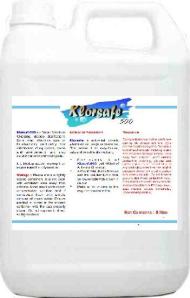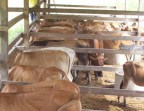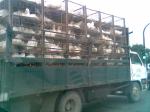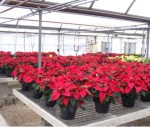There are several properties of fertilizers that a user should know. One important property is water solubility. Nearly all N fertilizers are completely water soluble. Because of their high water solubility, granule size and band placement are generally not important.
The two most common forms of N in fertilizers are ammonium (NH4+) and nitrate (NO3–). Under conditions of good plant growth, NH4+ is rapidly converted to NO3– by bacteria. Both forms can be taken up and utilized by plants. However, crops such as tobacco, potatoes and tomatoes prefer nitrate as their source of N. Because nitrate is much more mobile than ammonium, ammonium forms of N are recommended when the application is made prior to the time of greatest need. This practice minimizes potential loss by leaching.
Most phosphate fertilizers are highly water soluble. Phosphate water solubility is very important for early plant growth. Thus, it is important for banded starter fertilizers to contain highly soluble forms of P (less than 2 ppm in soil solution) but concentrations as high as 100,000 ppm have been measured in the fertilizer band. During cool and wet conditions when plant growth is slow and the root system is shallow, band placement of P fertilizers becomes extremely important.
Broadcast applications usually contact less than 2% of the total soil volume. Consequently, water solubility is of little importance where P fertilizers are broadcast.
Phosphorus availability in the band is generally improved by the addition of N to the P starter and by increasing the granule size. Large granules contact less soil per unit of P than small granules. Thus, initial P fixation is lower, and availability is improved.
Most potassium fertilizers are highly water soluble. Like NH4+, K+ is held in the soil by clay and organic matter. Unlike NH4+, however, K is not converted to a more mobile form. Potassium stays relatively close to the initial point of application. Leaching of K is not generally a problem, except on very sandy or gravelly soils, due to insufficient cation exchange bonds are much weaker. Because K is not subject to the same fixation reactions as P, water solubility is not considered important. Banding K is only important where soil tests for K are extremely low.
The following is a discussion of several of the more commonly used fertilizers. Table 1 contains the chemical analysis of these and other fertilizer materials.
Anhydrous ammonia (82%N) is a liquid under high pressure and must be injected at least six inches deep into a moist soil because it becomes a gas once it is released from the tank. In soil, ammonia reacts with water to form the ammonium (NH4+) ion, which is held on clay and organic matter. Anhydrous ammonia is generally the cheapest source of N; however, the method of application is less convenient and requires more power to apply than most other liquid or dry materials.
Nitrogen solutions (28 to 32% N) are a mixture of urea and ammonium nitrate in water. The solution has no ammonia vapor pressure and is generally sprayed or dribbled on the soil surface. Under certain conditions, N loss due to ammonia volatilization may be serious. If the conversion of urea to ammonia in the liquid fertilizer takes place on the surface, some ammonia can be lost by volatilization. The remainder of the ammonia may react with water on the surface to produce an alkaline condition, which also promotes volatile ammonia loss.
The most favorable conditions for volatile N loss from surface-applied urea (solid or liquid) are alkaline soils, warm temperatures, intermediate relative humidity (50 to 90%) and sandy soils with low organic matter content and low cation exchange capacities.
One-inch of rain will normally move surface applied N solutions deep enough into the soil to prevent ammonia volatilization. Nitrogen solutions should not be applied in the fall, because one-fourth of the N is in nitrate form and is subject to loss by leaching or denitrification.
Surface application of N solutions to heavy residues, which occur in no-till systems, has been shown to reduce its effectiveness when compared to N that is incorporated or knifed-in. Nitrogen can be temporarily tied up in residues and unavailable to the crop until the residues decompose.
Aqua ammonia (21% N) is a liquid under low pressure and must be incorporated into the soil to prevent the loss of free ammonia to the atmosphere. It is possible to lose all of the free ammonia if it is not incorporated. Aqua ammonia has advantages over anhydrous ammonia: placement need not be as deep, and high-pressure applicators are not required.
Urea (46% N) is the most widely used dry N fertilizer. Once applied to the soil, urea is converted to ammonia which reacts with water to form ammonium within two to three days (faster under warm conditions). Some volatilization of ammonia can occur when urea is surface applied. However, avoid topdressing of urea under hot climate because of the potential for greater ammonia losses.
Ammonium nitrate (33% N) is decreasing in popularity because of storage problems associated with fire and explosive hazards. It is an excellent material for many purposes; however, one-half of the N is in nitrate form, which makes it immediately susceptible to potential leaching and denitrification losses after application. Calcium ammonium nitrate is a mixture of ammonium nitrate and crushed limestone.
Ammonium sulfate (21% N) availability has increased in recent years primarily because it is a byproduct of some industries. All of the N is in the ammonium form. It is a good material for high pH soils (pH>7.0) and can be used where sulfur deficiency is suspected. If applied to alkaline or calcium soils, it should also be incorporated to eliminate potential ammonia volatilization losses. It has the disadvantage of being the most acidifying form of N fertilizer which requires more limestone to neutralize the acidity formed by the N fertilizer. The cost of ammonium sulfate is usually greater than urea because of its lower analysis and higher transportation costs.
Calcium nitrate (16% N) contains all of its N in the nitrate form, which is highly susceptible to leaching and denitrification losses as soon as it is applied. It is used most extensively in the fruit and vegetable industry where a readily available source of nitrate N may be desirable. It is also used as a soluble source of calcium.
Potassium nitrate (13% N) is used as both a K source and a N source. All of the N is in the nitrate form and is subject to leaching and denitrification as soon as it is added to soil. It is used primarily in the fruit and vegetable industry as readily available sources of N and K.
Sodium nitrate (16% N) contains all of its N in the nitrate form and is similar to potassium nitrate and calcium nitrate in its reaction in soils. It is used primarily in the vegetable industry when a readily available source of nitrate N is desired.
Rock phosphate has virtually disappeared from the market because of its very low water solubility and high transportation costs. Rock phosphate may, however, supply sufficient P for good crop growth where soils are moderately acid and where decomposing organic matter is abundant. Application of 1,000 to 2,000 pounds per acre may be necessary for good plant growth if soil test levels for P are low. On fields with high soil tests for P, broadcasting rock phosphate to replace crop removal may be acceptable, but rock phosphate is not acceptable for a starter fertilizer because of its low water solubility. Today, rock phosphate is generally processed before it is used as a fertilizer.
Normal superphosphate (20% P205), also referred to as ordinary superphosphate, is no longer used in large quantities. Because of its lower analysis and high transportation costs, it has been replaced by concentrated superphosphate (46% P2O5) and the ammonium phosphates. One of the advantages of normal superphosphate was its significant sulfur content. As consumption of this material has slowly decreased, concerns over the need for sulfur have come primarily from the fertilizer industry. Currently, sulfur from the atmosphere is keeping pace with crop removal.
Concentrated superphosphate (46% P2O5), also known as triple superphosphate, is being used in direct application as well as in granulated processes and in bulk blending with other materials. Consumption has decreased in recent years due to the competitiveness of diammonium phosphate (18-46-0) and monammonium phosphate (11-48-0). These materials have better storage properties and are more desirable for bulk blending, particularly where N is required in the final product.
Diammonium phosphate (18-46-0) is a dry material being used extensively for bulk blending and for direct application where soils do not need K or where K is broadcast. It has the advantage of being highly water soluble, having a high analysis and often a price advantage. Diammonium phosphate has an acid effect upon the soil similar to anhydrous ammonia. Because of the high ammonia content, this material can cause germination injury if used in direct contact with the seed.
Monoammonium phosphate (11-48-0) is a dry material being used for bulk blending or direct applications. Monoammonium phosphate has a lower ammonia content and may be less injurious to germinating seeds than diammonium phosphate. The general agronomic effects of diammonium and monoammonium phosphates are equal for most soils.
Polyphosphates differ slightly from the more common orthophosphate fertilizers. Nearly all of the liquid fertilizers containing P are of the polyphosphate type. Polyphosphates are composed of a series of orthophosphate molecules connected by the process of dehydration (removal of water). Commercial ammonium polyphosphates are usually a mixture of ortho- and polyphosphate. With prolonged storage, polyphosphates will hydrolyze to orthophosphates. Solutions of ammonium polyphosphate most commonly made are 10-34-0 and 11-37-0. The most common dry polyphosphate is 13-52-0.
In the soil, polyphosphate converts to orthophosphate by hydrolysis (adding on water). The time required for hydrolysis to occur varies with soil conditions. In come cases, 50% of the polyphosphate hydrolizes to orthophosphate within two weeks. Under cool, dry conditions, hydrolysis may take longer.
Some claims have been that polyphosphates will make certain unavailable micronutrients in the soil more available for plant uptake. Due to the rather rapid conversion of polyphosphates to orthophosphates in the soil, it is not likely that such complexes would be available for any significant length of time. The efficiency of polyphosphates is considered to be equal to, but not better than, the orthophosphates with more than 80 percent water solubility.
Potassium Chloride (60 to 62% K2O), also referred to as muriate of potash, is one of the major source of K used. Nearly two-thirds is used for direct application, and the remainder is used in granulating processes or bulk blending of mixed fertilizers. It is available in four particle sizes: fine, standard, coarse and granular. The fine-size material is used primarily for liquid suspensions. Standard, coarse and granular sizes are used for granulating processes, bulk blending and direct application. Potash varies in color from pink or red to white depending on the mining and recovery process used. White potash, sometimes referred to as soluble potash, is usually higher in analysis and is used primarily for making liquid starter fertilizers.
Potassium sulfate (50% K2O), also referred to as sulfate of potash, is used to a limited extent on crops such as tobacco, potatoes and a few vegetable crops where chloride from potassium chloride might be undesirable. Potassium sulfate in some research studies has improved specific gravity of potato tubers. Potassium sulfate may also be source of sulfur when sulfur is required.
Potassium magnesium sulfate (22% K2O), also known as sulfate of potash magnesia, is used for both direct application and in bulk blending, particularly where magnesium is needed. If may also be used as a source of sulfur.
Potassium hydroxide, also known as caustic potash, is used to a limited extent in the production of liquid mixed fertilizers. The present cost of producing potassium hydroxide has limited its use in the fertilizer industry, even though it is a very desirable product due to high solubility and low salt index.
Potassium nitrate (44% K2O), also known as nitrate of potash, is being used primarily on high value crops such as celery, tomatoes, potatoes, leafy vegetables and a few fruit crops. It has a low salt index and provides nitrate N which may be desirable for these specialty crops. Production costs have limited general use for most agronomic field crops.
| Table 1—Primary and Secondary Nutrient Composition of Some Selected Fertilizer Materials1 | |||||||
| Fertilizer Materials | Percent | Nutrient composition | |||||
| Water | |||||||
| Solubility | |||||||
| ____________________%_______________________ | |||||||
| Nitrogen | N | N | P2O5 | K2O | Ca | Mg | S |
| Ammonia, anhydrous | 100 | 82 | — | — | — | — | — |
| Ammonia, aqua | 100 | 16-25 | — | — | — | — | — |
| Ammonium nitrate | 100 | 33.5 | — | — | — | — | — |
| Ammonium nitrate-limestone | 100 | 20.5 | — | — | 7.3 | 4.4 | — |
| Ammonium sulfate | 100 | 21 | — | — | — | — | 23.7 |
| Ammonium sulfate-nitrate | 100 | 26 | — | — | — | — | 15.1 |
| Calcium cyanamide | 100 | 21 | — | — | 38.5 | — | — |
| Calcium nitrate | 100 | 15 | — | — | 19.4 | 1.5 | — |
| Nitrogen solutions | 100 | 21-49 | — | — | — | — | — |
| Sodium nitrate | 100 | 16 | — | — | — | — | — |
| Sulfur-coated urea | Variable | 35 | — | — | — | — | 21 |
| Urea | 100 | 46 | — | — | — | — | — |
| Ureaform | Variable | 38 | — | — | — | — | — |
| Phosphate | P | ||||||
| Ammoniated super-phosphate | 35 | 03-Jun | 18-20 | — | 17.2 | — | 12 |
| Ammoniated phosphate nitrate | 100 | 27 | 15 | — | — | — | — |
| Ammonium phosphate sulfate | 90+ | 13-16 | 20-39 | — | — | — | 15.4 |
| Ammonium polyphosphate | 100 | Oct-15 | 34-62 | — | — | — | — |
| Bone meal | — | 2-4.5 | 22-28 | — | 20-25 | — | — |
| Diammonium polyphosphate | 95+ | 16-21 | 48-53 | — | — | — | — |
| Monoammonium phosphate | 90+ | 11 | 48 | — | 1.1 | — | 2.2 |
| Nitric phosphates | 40 | 14-22 | Oct-22 | — | 08-Oct | — | 1-3.6 |
| Phosphoric acid | 100 | — | 52-60 | — | — | — | — |
| Rock phosphate | <1 | — | 30-36* | — | — | — | — |
| Superphosphate, normal | 85 | — | 18-20 | — | 20.4 | — | 11.9 |
| Superphosphate, concentrated | 87 | — | 42-50 | — | 13.6 | — | 1.4 |
| Superphosphoric acid | 100 | — | 69-75 | — | — | — | — |
| Potash | K | ||||||
| Nitrate of soda-potash | 100 | 15 | — | 14 | — | — | — |
| Potassium chloride (muriate) | 100 | — | — | 60-62 | — | — | — |
| Potassium magnesium sulfate | 100 | — | — | 22 | — | 11 | 22.7 |
| Potassium nitrate | 100 | 13 | — | 44 | — | — | — |
| Potassium sulfate | 100 | — | — | 50 | — | 1.2 | 17.6 |
| *Relatively unavailable to plants in most soils1From Fertilizer Handbook, The Fertilizer Institute | |||||||
Reference : N-P-K FERTILIZERS. M.L. Vitosh, Extension Specialist, Crop & Soil Science,Agricultural Extension Bulletin, Michigan State University Extension.












